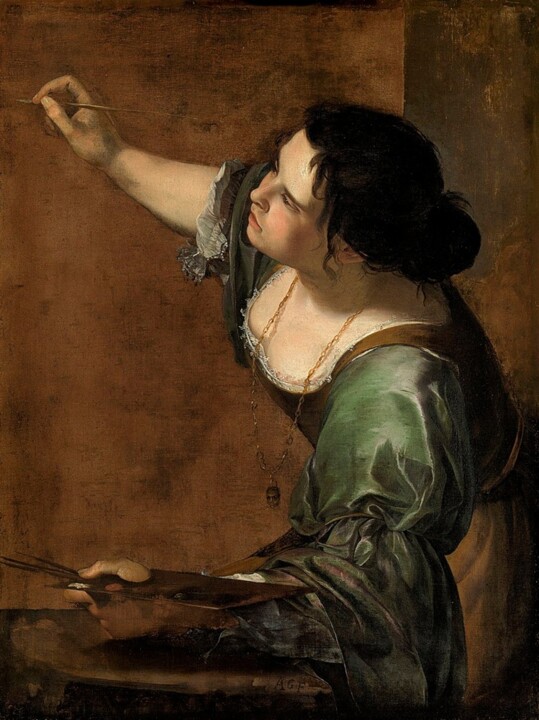
Artemisia Gentileschi, Self-portrait as an allegory of painting, 1638-1639. Oil on canvas, 98.6×75.2 cm. London: Kensington Palace, London.
Who was Artemisia Gentileschi?
Artemisia Lomi, also called Artemisia Gentileschi, was an Italian Baroque painter who lived from 1593 to around 1656. Gentileschi is thought to be one of the best artists of the 1600s. At first, she painted in the style of Caravaggio. By the time she was 15, she was making work for pay. Gentileschi was the first woman to join the Accademia di Arte del Disegno in Florence. At the time, women didn't have many chances to study art or work as professional artists.
She had clients from all over the world. Many of Gentileschi's paintings show women from myths, allegories, and the Bible, such as victims, warriors, and women who killed themselves. Susanna and the Elders (especially the 1610 version in Pommersfelden), Judith Killing Holofernes (the 1614–1620 version is in the Uffizi gallery), and Judith and Her Maidservant (her version of 1625 is in the Detroit Institute of Arts) are some of her most well-known works. Gentileschi was known for how realistically she could paint women and how well she could use color to add depth and drama to her work. Long before she became famous as an artist, Agostino Tassi raped her when she was a young woman, and she testified against him in court.
Gentileschi was thought of as a strange person for a long time, but in the 20th and 21st centuries, scholars have looked at her life and art again. She is now seen as one of the most progressive and expressive painters of her generation. Her talents have been recognized by major exhibitions at internationally renowned fine art institutions, such as the National Gallery in London.
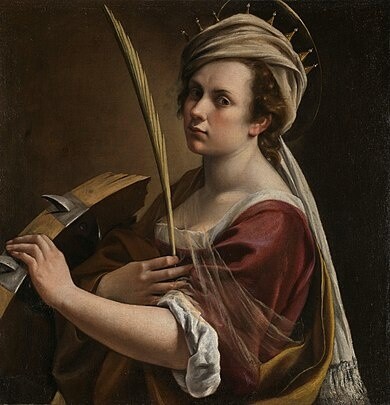
Artemisia Gentileschi, Self-portrait as Saint Catherine of Alexandria, 1615-1617. Oil on canvas, 71.4×79 cm. London: National Gallery.
What are three key concepts related to Artemisia?
- Although stylistically Artemisia Gentileschi's work owes a debt to that of Caravaggio and her father Orazio, her paintings place a greater emphasis on realism than her predecessors. Her compositions are also more energetic and during her career she carefully refined the use of texture and color, becoming known for her rich jewel hues and realistic flesh tones.
- Gentileschi subverted traditional depictions of the female protagonists of biblical and mythological stories presenting them as self-motivated heroines capable of making their own decisions rather than passive objects of the male gaze. By doing this, she showed them in a whole new way, which gave them power that other artists had been unable to give them.
- The artist was sexually assaulted when she was a teenager, which affected a lot of her work. Many of her paintings have themes of abuse of power, rape, and violence. It is likely that painting these subjects allowed her to process the trauma of her assault and to seek revenge and redress through her artworks.
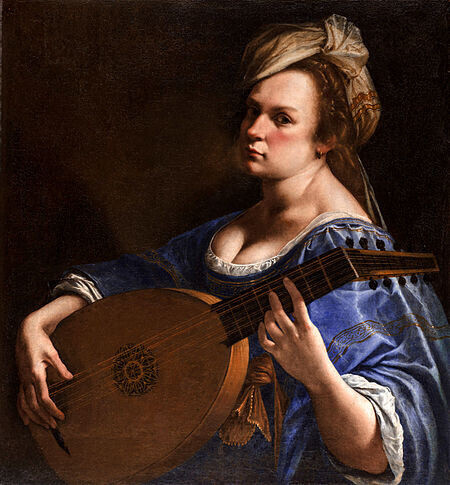
Artemisia Gentileschi, Self-portrait as a lute player, 1615-1617. Oil on canvas, 71.4×79 cm. Minneapolis: Curtis Galleries.
How did Artemisia begin to paint?
Even though her birth certificate from the Archivio di Stato says she was born in 1590, Artemisia Lomi Gentileschi was born in Rome on July 8, 1593. She was the eldest child of Prudenzia di Ottaviano Montoni and the Tuscan painter Orazio Gentileschi. Orazio Gentileschi was a painter from Pisa. After he moved to Rome, his paintings became more expressive. He was influenced by Caravaggio's new ideas, which led him to paint real people without making them look better or sweeter. Instead, he turned them into figures with strong, realistic drama.
Artemisia was baptized two days after she was born at the church of San Lorenzo in Lucina. After her mother died in 1605, Artemisia was mostly raised by her father. It was likely at this time that Artemisia approached painting: introduced to painting in her father's workshop, Artemisia showed much more enthusiasm and talent than her brothers, who worked alongside her. She learned how to draw, blend colors, and paint. By the time she was 18, Artemisia was known for her amazing skills. Her father said that she was the best painter he had ever seen, even though she had only been painting for three years.
During this early period of her life, Artemisia took inspiration from her father's painting style, which had in turn been heavily influenced by the work of Caravaggio. Artemisia, on the other hand, took a much more realistic approach to her subjects than her father did. Her father's works, on the other hand, were more idealized. At the same time, Artemisia had to overcome the traditional attitude and psychological submission to this brainwashing and jealousy of her obvious talent. She got a lot of respect and attention for her work because of this.
Susanna and the Elders, which she wrote when she was 17, is her earliest work that has survived. It is in the Schonborn collection in Pommersfelden. The painting depicts the Biblical story of Susanna. The painting shows how Artemisia took on Caravaggio's realism and effects without ignoring Annibale Carracci's classicism and the Bolognese School of Baroque style.

Artemisia Gentileschi, Susanna and the Elders, 1649. Oil on canvas, 205 x 167.5 cm. Brno: Moravian Gallery..
One of the most famous rapes in art!
Orazio and Agostino Tassi were working together in Rome in 1611 to decorate the vaults of the Casino delle Muse in the Palazzo Pallavicini-Rospigliosi. In May, Tassi went to the Gentileschis' house and raped Artemisia when she was alone with him. Cosimo Quorli, another man, also took part in the rape. Gentileschi's friend Tuzia was there when she was raped, but she didn't help her.
Artemisia started having sexual relations with Tassi because she thought they would get married. She thought this would help her get back to being good and secure her future, but Tassi broke his promise to marry her. When Artemisia's father, Orazio, found out that Artemisia and Tassi weren't going to get married nine months after the rape, he filed charges against Tassi. The main point of the trial was that Tassi had hurt the honor of the Gentileschi family, and Artemisia was not charged with anything.
During the seven-month trial that followed, Tassi's plans to kill his wife, have an affair with his sister-in-law, and steal some of Orazio's paintings were revealed. At the end of the trial, Tassi was told he had to leave Rome, but this was never done. During the trial, Artemisia's testimony was checked by torturing her with thumbscrews.
After her mother died, Artemisia spent most of her time with men. Orazio rented the upstairs apartment of their house to a woman named Tuzia when she was 17 years old. Artemisia befriended Tuzia; however, Tuzia allowed Agostino Tassi and Cosimo Quorli to visit Artemisia in Artemisia's home on multiple occasions. Artemisia asked Tuzia for help on the day she was raped, but Tuzia ignored her and pretended she didn't know what was going on. Jeanne Morgan Zarucchi, an art historian, compared Tuzia's betrayal and her role in making the rape possible to the role of a procuress who helps a prostitute get sexually exploited.
Gentileschi may or may not have made a painting called "Mother and Child," which was found in Crow's Nest, Australia, in 1976. If it is her work, the baby has been seen as a reference to Agostino Tassi, the man who raped her, because it was made in 1614, just two years after the rape. It shows a strong, suffering woman and shines a light on her pain and her ability to express herself through art.
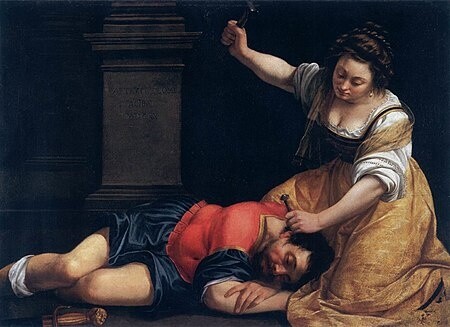
Artemisia Gentileschi, Giaele and Sisara, 1620. Oil on canvas, 86 × 125 cm. Budapest: Museum of Fine Arts.
Artemisia precursor of feminism!
Roberto Longhi, an Italian critic, wrote a research paper in 1916 called "Gentileschi, father and daughter." In it, he called Artemisia " he only woman in Italy who ever knew about painting, coloring, drawing, and other fundamentals." Longhi also said this about Judith Killing Holofernes: " There are about fifty-seven works by Artemisia Gentileschi and 94% (forty-nine works) feature women as protagonists or equal to men." These include Esther, Judith and Her Maidservant, and Jael and Sisera. These characters didn't have the typical "feminine" traits of sensitivity, shyness, and weakness on purpose. Instead, they were brave, rebellious, and strong (such subjects are now grouped under the name the Power of Women). A critic from the 1800s said this about Artemisia's Magdalene: "No one would have thought that a woman had done it. The brushwork was bold and sure, with no sign of being afraid ". Raymond Ward Bissell thought that she knew how men saw women and female artists, which is why her early works were so bold and defiant.
Feminist studies brought more attention to Artemisia Gentileschi by focusing on the fact that she was raped and then mistreated, as well as the expressive power of her paintings of biblical heroines, in which the women are seen as rebelling against their situation. In a research paper from the catalogue of the "Orazio and Artemisia Gentileschi" exhibition, which took place in Rome in 2001 (and then in New York), Judith W. Mann criticizes feminist views of Artemisia. She finds that old stereotypes of Artemisia as sexually immoral have been replaced by new stereotypes established by feminist readings of Artemisia's paintings.
Some art historians think that Artemisia kept coming back to violent subjects like Judith and Holofernes out of repressed anger. Other art historians think that she was smartly using her fame from the rape trial to fill a niche market for sexually charged, female-dominated art with male patrons.
The most recent critics have tried to give a less simplistic view of Artemisia's career by putting it in the context of the different art scenes she was a part of. They did this by starting with the difficult task of putting together the entire catalogue of the Gentileschi. A reading like this brings back Artemisia as an artist who fought with determination, using her personality and artistic skills as weapons, against the prejudices that were held against women painters. She was able to make a good name for herself among the most respected painters of her time, working in a number of styles that were probably broader and more diverse than what her paintings show.
Artemisia Gentileschi has been important to feminists since the 1970s, when Linda Nochlin, a feminist art historian, wrote an article called "Why Have There Been No Great Women Artists?" in which she tried to answer that question. The article looks at what it means to be a "great artist," and it says that women haven't gotten the same level of recognition in art and other fields as men have because of oppressive institutions, not because they aren't as talented. Nochlin said that studying Artemisia and other women artists was worth the time because it helped us learn more about what women have done in art history and art history in general. Eve Straussman-Violence Pflanzer's & Virtue: Artemisia's Judith Slaying Holofernes has a foreword by Douglas Druick that says Nochlin's article made scholars try harder to include women artists in the history of art and culture.
Artemisia and her work were once again the focus of art history. Before that, only Roberto Longhi's 1916 article "Gentileschi, father and daughter" and Bissell's 1968 article "Artemisia Gentileschi—A New Documented Chronology" paid much attention to them. As art historians and feminists began to pay more attention to Artemisia and her work, more fiction and nonfiction books about her were written. Anna Banti, who was married to the critic Roberto Longhi, made up a story about her life that came out in 1947. Literary critics liked this story, but feminists, especially Laura Benedetti, said it wasn't historically accurate enough so that it could be used to compare the author to the artist. Mary Garrard, a feminist art historian, wrote The Image of the Female Hero in Italian Baroque Art, which was the first full, factual account of Artemisia's life. It came out in 1989. In 2001, she wrote a second, smaller book called Artemisia Gentileschi around 1622: The Shaping and Reshaping of an Artist's Identity. It was about the artist's work and identity. Garrard said that analyzing Artemisia's work outside of "woman" is hard because it lacks focus and stable categories. He also questioned whether "woman" is a good category to use to judge her art at all.
Artemisia is known for her Power of Women-themed works, such as her versions of "Judith Killing Holofernes." She is also known for the rape trial she was in. Scholar Griselda Pollock has said that the trial has become the main way people look at the artist's work, which is a shame. Pollock thinks that Gentileschi's place in popular culture has less to do with her work and more to do with how shocking it was that the rape trial in which she was tortured got so much attention. Pollock gives a different way to look at the artist's dramatic, story-based paintings. For example, he doesn't think that the paintings of Judith and Holofernes are about rape and the trial. Pollock instead says that the story of Judith and Holofernes isn't about revenge. Instead, it's about two women working together to commit a daring political murder during a war, which Pollock says is a story about political courage.
Pollock wants to move the focus away from sensationalism and toward a deeper analysis of Gentileschi's paintings, especially those about death and loss. He suggests that her childhood loss may have been the source of her unique pictures of Cleopatra as she was dying. Pollock also says that Gentileschi's success in the 1600s depended on her painting for patrons, who often asked her to paint things that reflected the tastes and fashions of the time. She wants to show how Gentileschi's career fits into the historical trend of liking dramatic stories about Bible or classical heroines.
In a different way, American professor Camille Paglia has said that modern feminists are wrong to be so interested in Artemisia and that her achievements have been exaggerated: Artemisia Gentileschi was just a polished, skilled painter who used a style called Baroque that was made by men. Still, The National Gallery says that Artemisia worked in Rome, Florence, Venice, Naples, and London for people like the Grand Duke of Tuscany and Philip IV of Spain, who were at the top of European society.
Artemisia's rape is often the focus of feminist literature, which tends to show her as a traumatized but brave survivor whose work is full of sex and violence because of what happened to her. Pollock (2006) saw Agnès Merlet's film as a typical example of how popular culture can't look at the painter's amazing career over many decades and in many of the world's most important art centers, but only at this one episode. Laura Benedetti's literature review, "Reconstructing Artemisia: Twentieth Century Images of a Woman Artist," came to the conclusion that Artemisia's work is often interpreted based on the issues of the time and the authors' personal preferences.
For example, feminist scholars have made Artemisia an icon of feminism. Benedetti said this was because Artemisia painted strong women and was successful as an artist in a field dominated by men while also being a single mother. Elena Ciletti, who wrote Gran Macchina a Bellezza, said that Artemisia's case has a lot at stake, especially for feminists, because so much of our intellectual and political work for justice for women, both in the past and now, has been put into her.
Feminist scholars think that Artemisia was trying to fight against the idea that women should be submissive. Between 1630 and 1635, she wrote Corisca and the Satyr, which has a lot of symbolism. In the painting, a satyr is chasing a nymph. The satyr tries to grab the nymph by her hair, but it's a wig. In this scene, Artemisia shows that the nymph is very smart and is fighting back against the satyr's attack.
What are the works of Artemisia?
- Self-Portrait as Saint Catherine of Alexandria, 1615-1617, National Gallery, London.
- Aurora, 1625-7, Private Collection.
- Allegory of Painting, 1630s, Private Collection.
- Saint Apollonia, 1642-1644, Museo Soumaya, Mexico City.
- Penitent Magdalene, 1630s, Private Collection.
- Lucretia, 1645-50, Neues Palais in Potsdam.
- Susanna and the Elders, 1610-1, Schloss Weißenstein.
 Oil on canvas, 170 x 119 cm.
Oil on canvas, 170 x 119 cm.
The painting shows a Bible story from Chapter 13 of the Book of Daniel, as held by the Catholic and Eastern Orthodox churches, but not by most Protestants. A young married woman named Susanna is being watched by two old men. Susanna was taking a bath in the garden when her housekeeper let the two older people in. The elders watched Susanna and then asked her for sexual favors, which she turned down. The men said they would ruin her name, but Susanna didn't back down. The two elders then made up a lie about Susanna being an adulterer, which was a crime that could get you killed. When a young Hebrew wise man named Daniel talked to each of them separately, he saw that some details in the stories of the two elders didn't match up. Their different stories showed that their testimony was false, which cleared Susanna's name. From the 16th century on, this theme was often found in European art, and Susanna was often used as an example of modesty and loyalty. In practice, though, it gave artists a chance to show how good they were at drawing naked women, often to the pleasure of their male customers.
- Madonna and Child, 1610-1, Galleria Spada.
- Madonna and Child, c. 1630, Palazzo Pitti, Florence.
- Cleopatra, 1611-2, Private Collection.
- Danae, 1612, Saint Louis Art Museum.
- Judith Slaying Holofernes, 1611-2, Museo Nazionale di Capodimonte.

Oil on canvas, 158.8 cm × 125.5 cm.
When she painted "Judith Slaying Holofernes," Artemisia Gentileschi was about twenty years old. Gentileschi had already finished Susanna and the Elders and Madonna and Child before this. These works of art already show how good Gentileschi was at showing emotions through body movement and facial expressions. X-rays of the painting show that Gentileschi made several changes to it before it got to where it is now. For example, he moved Judith's arms and changed the way the drapery was hung.
- Allegory of Inclination, 1615, Casa Buonarroti.
- Portrait of a Nun, 1613-8, Private Collection.
- Self-Portrait as a Female Martyr, c.1615, Private Collection.
- Self-Portrait as a Lute Player, 1616-18, Wadsworth Atheneum, Villa Medici.
- Mary Magdalene, 1616–17, Palazzo Pitti.
- Saint Catherine of Alexandria, c.1618-9, Uffizi.
- Judith and her Maidservant, c.1618-9, Palazzo Pitti, Florence.

Oil paint, 114 x 93.5 cm.
The painting shows Judith and her servant Abra running away from Holofernes' tent right after Judith has killed Holofernes and is on her way to safety.
Gentileschi painted this subject several times during her career. She paints two versions of the same scene, Judith Slaying Holofernes (Naples) and Judith Slaying Holofernes, which show the moment when Judith killed Holofernes (Florence). This depiction of the time after the assassination is based on a painting by the artist's father, Orazio Gentileschi, who was done earlier.
- Mary Magdalene in Ecstasy, 1620, private collection.
- Jael and Sisera, 1620, Museum of Fine Arts, Budapest.
- Judith Slaying Holofernes, 1620-1, Uffizi.
- Saint Cecilia, c.1620, Galleria Spada.
- Allegory of Painting, 1620s, Musee de Tesse, Le Mans.
- Susanna and the Elders, 1622, Burghley House.
- Susanna and the Elders, c. 1630, Nottingham Castle.
- Portrait of a Gonfaloniere, 1622, Palazzo d'Accursio.
- Lucretia, c.1623-5, Collection Gerolamo Etro, Milan.
 Oil on canvas, 100 x 77 cm.
Oil on canvas, 100 x 77 cm.
Lucretia was a Roman heroine who was known for being beautiful and humble. According to a story that Livy wrote about in his book History of Rome, her husband Collatinus thought she was a very good person. She was raped by Sextus Tarquinius, a Roman nobleman who was related to her husband. If she tried to stop him, he threatened to kill her and make her body look bad in public. Given the risk of being shamed, she gave in to his sexual demands, but then told her husband and father about the attack before killing herself. By doing this, she kept her honor and goodness (according to Roman beliefs). Her decision to kill herself led to a revolt that toppled the Etruscan monarchy and started the Roman Republic.
- Penitent Magdalene, c.1625-6, Seville Cathedral.
- Mary Magdalene as Melancholy, 1620s, Museo Soumaya
- Judith and Maidservant with Head of Holofernes, c.1625-7, Detroit.
- Judith and Maidservant with Head of Holofernes, c.1640s, Museo di Capodimonte, Naples.
- Judith and her Maidservant (Cannes), c.1640s Musee de la Castre, Cannes.
- Venus and Cupid, c.1625-30, Virginia Museum of Fine Arts.

Oil, 96.52 × 143.83 cm.
Venus and Cupid, also known as "Sleeping Venus," is a painting by Artemisia Gentileschi from around 1626. It is on display at the Virginia Museum of Fine Arts. Venus and Cupid is a picture of a sleeping Venus who is lying on a rich crimson and gold-tasseled pillow on a blue bedcover. She only has a thin piece of clear linen wrapped around her thigh. As she drifts off to sleep, her son Cupid fans her with peacock feathers that have a lot of color. He is looking at her with a look of love and rapture on his face. In the background, there is a window that looks out onto a moonlit landscape with a goddess temple. Venus's face has full cheeks, heavy eyelids, and a small chin that sticks out. The way Venus's body moves is natural. Her hand rests lightly on her side, and her legs are laid together in a soft way. Through its symbols and the way the artist painted it, the work is a mix of realism and classicism.
- Esther before Ahasuerus, c.1628-35, Metropolitan Museum of Art.
- Christ Blessing the Children, c.1640s, formerly MET.
- Annunciation, 1630, Museo Nazionale di Capodimonte.
- Penitent Magdalene, c.1630-2, Private Collection.
- Corisca and the Satyr, c.1630-5, Private Collection.
- Self Portrait, c.1630-5, Palazzo Barberini Rome.
- Clio: the Muse of History, 1632, Palazzo Blu.
- Cleopatra, 1633-5, Private Collection.
- Nativity of St. John the Baptist, 1633-5, Museo del Prado.
- Lot and his Daughters, 1635-8, Toledo Museum of Art.
- The Martyrdom of St Januarius in the Amphitheatre at Pozzuoli, 1636-7, Museo Nazionale di Capodimonte.
- Adoration of the Magi, 1636-7, Museo Nazionale di Capodimonte.
- Saint Proculus of Pozzuoli and his mother Santa Nicaea, 1636-7, Museo Nazionale di Capodimonte.
- David and Bathsheba, c.1636-8, Columbus Museum of Art.
- David and Bathsheba, 1645, Prussian Palaces and Gardens Foundation Berlin-Brandenburg.
- Bathsheba, 1638, Private Collection.
- David and Bathsheba, 1645, Palazzo Pitti.
- Bathsheba, 1640-45, Private Collection.
- Self-Portrait as the Allegory of Painting, 1638-9, Royal Collection.

Oil on canvas, 98.6 × 75.2 cm.
The painting shows feminist ideas that were unusual at a time when women rarely held jobs, let alone were known for them. Gentileschi's painting of herself as the best of the arts was a bold move for the time. However, the painting is now overshadowed by many of Gentileschi's other, more dramatic and raw scenes that show the artist's troubled youth.
- Susanna and the Elders, 1649, Moravian Gallery in Brno.
- Susanna and the Elders, 1650, Bassano Civic Museum.
- Susanna and the Elders,1652, Pinacoteca Nazionale di Bologna.
- Virgin and Child with a Rosary, 1651, El Escorial.
- Samson and Delilah,1630-38, Palazzo Zevallos, Naples.

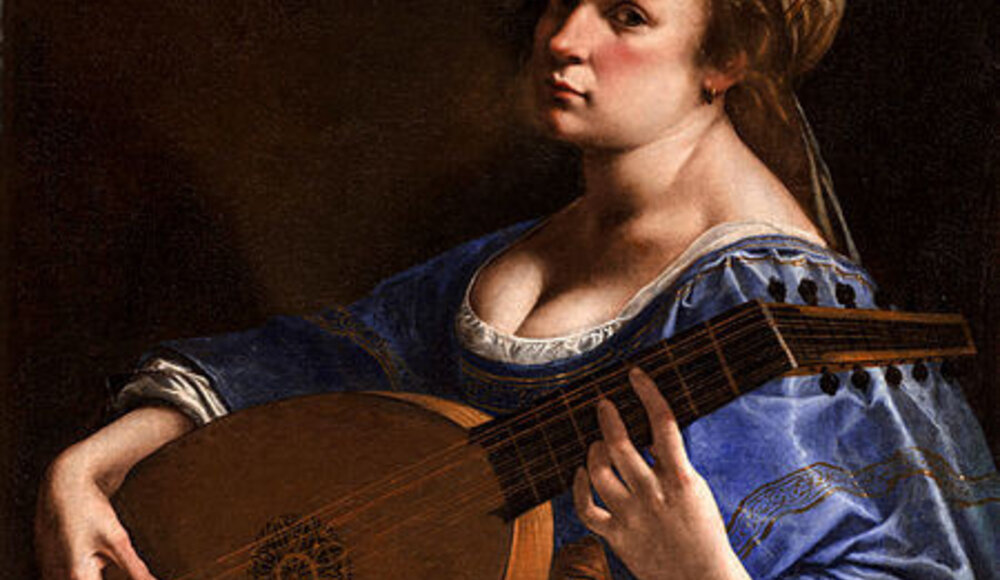
 Selena Mattei
Selena Mattei





